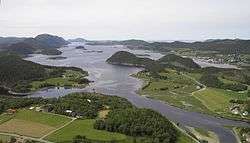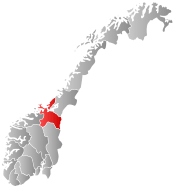Åfjord
| Åfjord kommune | |||
|---|---|---|---|
| Municipality | |||
 | |||
| |||
 Åfjord within Sør-Trøndelag | |||
| Coordinates: 63°58′40″N 10°23′8″E / 63.97778°N 10.38556°ECoordinates: 63°58′40″N 10°23′8″E / 63.97778°N 10.38556°E | |||
| Country | Norway | ||
| County | Sør-Trøndelag | ||
| District | Fosen | ||
| Administrative centre | Årnes | ||
| Government | |||
| • Mayor (2007) | Vibeke Stjern (Ap) | ||
| Area | |||
| • Total | 955.09 km2 (368.76 sq mi) | ||
| • Land | 895.72 km2 (345.84 sq mi) | ||
| • Water | 59.37 km2 (22.92 sq mi) | ||
| Area rank | 113 in Norway | ||
| Population (2010) | |||
| • Total | 3,220 | ||
| • Rank | 253 in Norway | ||
| • Density | 3.6/km2 (9/sq mi) | ||
| • Change (10 years) | -5.4 % | ||
| Demonym(s) | Åfjording[1] | ||
| Time zone | CET (UTC+1) | ||
| • Summer (DST) | CEST (UTC+2) | ||
| ISO 3166 code | NO-1630 | ||
| Official language form | Neutral | ||
| Website |
www | ||
|
| |||
Åfjord is a municipality in Sør-Trøndelag county, Norway. It is part of the Fosen region. The administrative centre of the municipality is the village of Årnes. Other villages in the municipality include Revsnes, Harsvika, and By. Åfjord is located on the northwestern side of the Fosen Peninsula, northwest of county capital of Trondheim between the municipalities of Bjugn and Osen and to the west of Verran in the neighboring county of Nord-Trøndelag.[2]
General information

The municipality of Aafjord was established on 1 January 1838 (see formannskapsdistrikt). On 26 March 1870, a royal resolution moved a small, unpopulated part to Aafjord to neighboring Bjugn. On 1 January 1896, the Jøssund area was separated from Aafjord to form a municipality of its own, leaving Aafjord with 2,419 residents. On the same date, the name of Aafjord was changed to just Aa. The spelling was later changed to Å. On 13 July 1934, the name of the municipality was changed from "Å" to "Åfjord". After that, the administrative centre in the municipality was referred to as "Å" or "Å i Åfjord". On 1 January 1964, the municipality of Stoksund was merged with Åfjord to form the new, larger municipality of Åfjord. Prior to the merger, Åfjord had 2,643 residents.[3] On 1 November 1980, the postal service changed the name of the municipal center from "Å i Åfjord" to "Årnes".
Name
The municipality is named after the Åfjorden. The first element is the name of the farm and the churchsite Å (Old Norse: Ár). This name is the plural form of á which means "river", probably since there are two rivers, the Norddalselva and Stordalselva, that run together south of the farm.[4] The name has varied over the years: Aafjord (1838 to 1896), then Aa or Å (1896 to 1934), and finally Åfjord (since 1934).
Coat-of-arms
The coat-of-arms is from modern times. They were granted 1997. The arms show two stems of a boat to represent the special boats Norwegian: Åfjordbåt that are built in the municipality.[5]
Churches
The Church of Norway has two parishes (sokn) within the municipality of Åfjord. It is part of the Deanery (prosti) of Fosen and the Diocese of Nidaros.
| Parish (Sokn) | Church Name | Year Built | Location of the Church |
|---|---|---|---|
| Åfjord | Åfjord Church | 1879 | Årnes |
| Stoksund | Stoksund Church | 1825 | Revsnes |
History

There are archeological findings on many sites across the municipality. On Dragseid archaeologists have located grave mounds. On Dragseid it is said that the wooden boats were dragged over this thin peninsula to shorten the journey and to avoid risking them in bad weather. Up to the Middle Ages the Fosen Peninsula was recognized as a part of Sunnmøre.
Prior to 1950, there were no roads leading into and out of the municipality. In 1950 the road to the neighboring municipality of Bjugn to the south was finally finished. In 1955, the road to Stokksund in the northern part of the municipality was finished.
An old type of wooden boat, the Åfjord boat, comes from this area. The boat is a direct descendant form the old Norse Viking boats. It is still being produced, although in very small numbers. The boat is rounded at both ends. It is known to be a good coastal sailer. Different sizes exist. From the small "faering" to the largest of them all, the "fembøring".
Government
All municipalities in Norway, including Åfjord, are responsible for primary education (through 10th grade), outpatient health services, senior citizen services, unemployment and other social services, zoning, economic development, and municipal roads. The municipality is governed by a municipal council of elected representatives, which in turn elect a mayor.
Municipal council
The municipal council (Kommunestyre) of Åfjord is made up of 21 representatives that are elected to every four years. Currently, the party breakdown is as follows:[6]
| Party Name | Name in Norwegian | Number of representatives | |
|---|---|---|---|
| Labour Party | Arbeiderpartiet | 8 | |
| Progress Party | Fremskrittspartiet | 2 | |
| Conservative Party | Høyre | 3 | |
| Christian Democratic Party | Kristelig Folkeparti | 2 | |
| Centre Party | Senterpartiet | 5 | |
| Liberal Party | Venstre | 1 | |
| Total number of members: | 21 | ||
Economy
The people of Åfjord make their living from agriculture, forestry, fishing, transport (sea and land), aquaculture (fish and shellfish), construction, and services. The largest employer in the area is Stjern (forestry, sawmill, entrepreneur). The contractor, building, sector now employs about 19% of the working force, and is now larger than the agricultural sector.
Geography

The major centre of the municipality is Årnes (also called "Å in Åfjord"). All major services of the municipality are located there. Other populated areas are Monstad/Å, a couple of minutes by car from Årnes, and Stoksund/Revsnes. Åfjord covers an area of approximately 1,000 square kilometres (390 sq mi), with about 3200 residents— about one third of which live in the Årnes urban area. During the last decades there has been a decrease of 100-150 people yearly. Many young people leave the municipality for school, university or work.
Åfjord consists of many small settlements—from the islands in the west to the highlands in the east. Traditionally, Åfjord has been an agricultural society, while Stoksund in the west has had a more of a fishing-based economy. There is an increasing amount of weekend houses and recreational cabins in the area. Åfjord has two big islands; Stokkøya (380 inhabitants) and Linesøya (80 inhabitants). Stokkøya is connected with the mainland through a bridge Stokkøy Bridge. The Linesøy Bridge between Stokkøya and Linesøya is currently (2009) under construction, but the project is heavily deleayed. The other main island is Lauvøya near the south at the end of the Åfjorden.
The highest point in Åfjord is the 676-metre (2,218 ft) tall Finnvollheia. There are over 1,000 lakes with fish. Åfjord also has two major salmon rivers—the Nordalselva and Stordalselva, which flow into Åfjorden. English Lords used to fish here in the late 19th century. The lake Stordalsvatnet lies just east of Årnes.
References
- ↑ "Navn på steder og personer: Innbyggjarnamn" (in Norwegian). Språkrådet. Retrieved 2015-12-01.
- ↑ Morten Haugen. "Åfjord". Store norske leksikon. Retrieved October 1, 2016.
- ↑ Jukvam, Dag (1999). "Historisk oversikt over endringer i kommune- og fylkesinndelingen" (PDF) (in Norwegian). Statistisk sentralbyrå.
- ↑ Rygh, Oluf (1901). Norske gaardnavne: Søndre Trondhjems amt (in Norwegian) (14 ed.). Kristiania, Norge: W. C. Fabritius & sønners bogtrikkeri. p. 23.
- ↑ "Åfjord kommunes kommunevåpen" (in Norwegian). Åfjord kommune. Retrieved 2008-10-28.
- ↑ "Table: 04813: Members of the local councils, by party/electoral list at the Municipal Council election (M)" (in Norwegian). Statistics Norway. 2015.
External links
 Sør-Trøndelag travel guide from Wikivoyage
Sør-Trøndelag travel guide from Wikivoyage- Municipal fact sheet from Statistics Norway
- Abstract:The biological diversity of Åfjord

